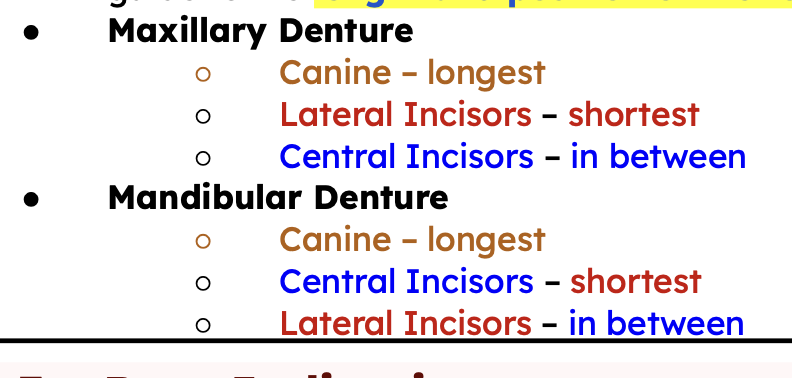Topic 2: Setting up the teeth
1/103
There's no tags or description
Looks like no tags are added yet.
Name | Mastery | Learn | Test | Matching | Spaced |
|---|
No study sessions yet.
104 Terms
★ Preservation of the alveolar bone
★ Esthetics
★ Masticatory Efficiency
★ Retention and Stability during Function
★ Health & Comfort of the TMJ
AIMS OF SETTING
true
true or false
The upper teeth should overlap the lower teeth
true or false
The long axis of each upper tooth should be distal to the long axis of the corresponding lower tooth
true
true or false
Each tooth except the lower central incisors and the
upper last molars should be opposed by two teeth
Set the teeth where they grew
PAYNE stated “____”
Anteroposterior Position
distance from papilla, relation to residual ridge, fullness of the lips ( l i p su p port ) , phonetics F & V
show of teeth, modiolus (lower canine and premolar)
Mediolateral Position
midline, ala of the nose
Inclination of slant
labial plate & facial profile
true or false
Both upper & lower posterior teeth are centered over the crest of the ridge whenever possible to improve balance and stability of the denture

Guides to Positioning of Posterior Teeth
POUNDS TRIANGLE
where you should set your posterior teeth
Class 1
Overjet 2-4mm
Class 1
Overbite ( 1mm excessive overbite avoided)
class 1- First Molar Relation
( Mb cusp of upper opposes buccal groove of lower)
Lingual
Functional of Upper:
Buccal
Functional of Lower:
Class 2
Pronounced overjet
Class 2- Lower canine
____more posterior and lingual
Class 2- Lower premolar
_____maybe ground mesiodistally or removed
Class 2
Nonanatomic teeth or teeth with shallow inclines are selected to reduce stresses on the lower
Class 2
are flattened to stabilized centric occlusion
class 2
Molars maintained cusps to fossae relation
Class 3
Overjet overbite eliminated
Class 3
Incisors can be set edge to edge
Class 3
Upper anteriors set are far forward for lip supports
and esthetics; lowers as far lingual without tongue
interference
class 3
Upper premolar maybe removed or add lower teeth
( pr emol ar or mol ar )
class 3
Molars maybe set in crossbite
Class 3
Buccolingual inclines & transverse ridges of
posteriors are flattened
Cross over point
the point at which the teeth change from one
relationship to another
CROSS-OVER POINT
the crossover point could be at the 2nd premolar
CROSS-OVER POINT
teeth may be set in an end-on or cusp to cusp
relation
TWICE
Trial Fitting in Clinics, done ___
Esthetics
Retention
Phonetics
Role of Polished Surface (ERPEH)
Esthetics
imitate the form of the tissues around the teeth
Retention
form of denture base be shaped according the muscles and tissues ( l i ps , ch eek s ,
t on g ue )
Phonetics
contour comparable to that of the palate
Waxing
Defined as the contouring of the wax base of a trial denture into the desired form
Festooning
The procedure of carving the denture base to
stimulate the contour of the natural tissues which
are being replaced by the denture
Cervical cut
Placement of triangular markings
root indications
PROCEDURES IN FESTOONING
Cervical cut
cut wax back to the cervical line on the artificial teeth, or a little beyond to stimulate gingival recession
sharp instrument is HELD at a 45 degrees angle to the tooth surface

Placement of Triangular Markings
guide to the length and position of the root indications
Root Indications
wax is scraped out of the triangular markings, to which the
root indications will manifest
Palatal surface
It has a uniform thickness of 2.5 mm